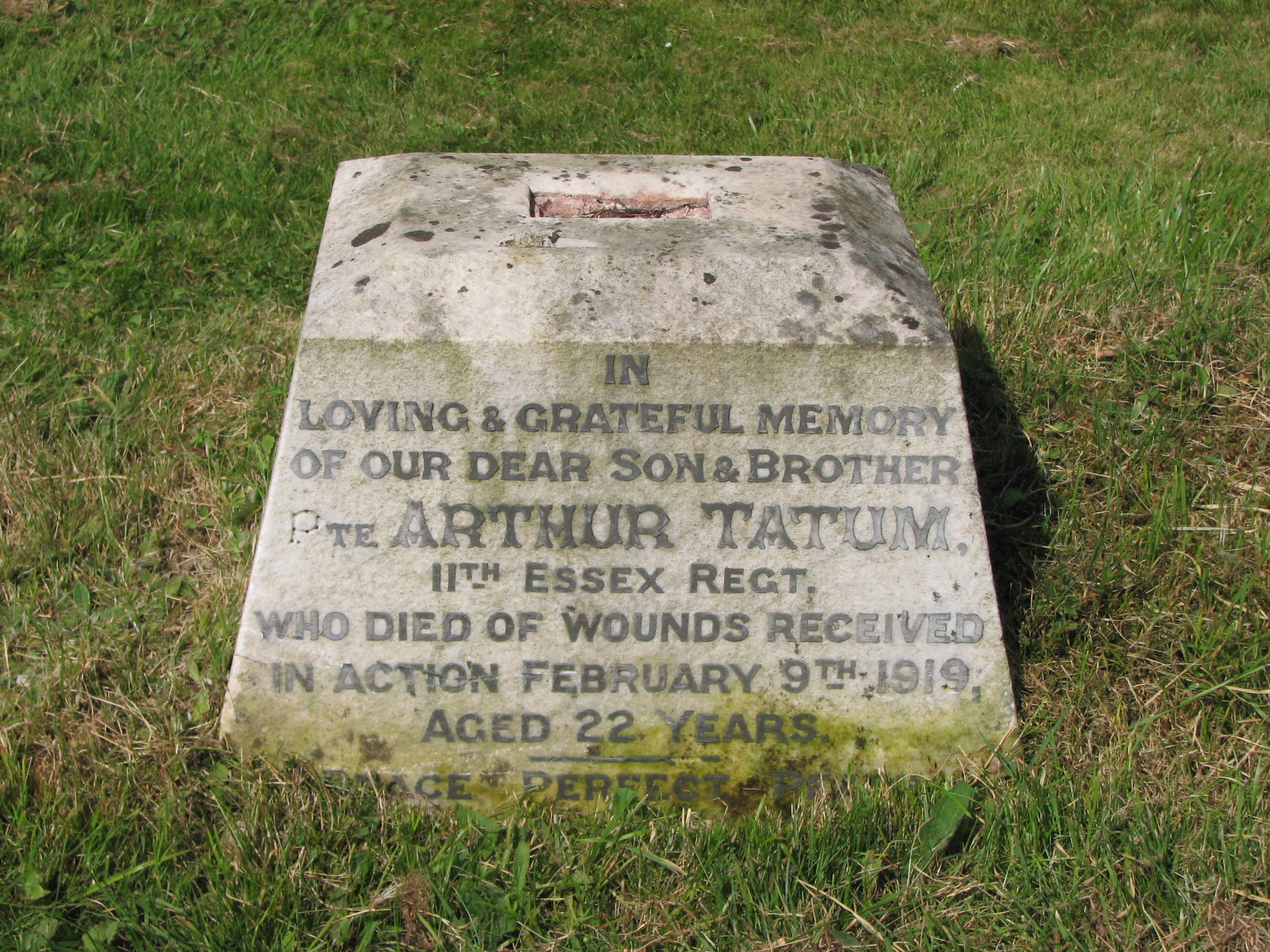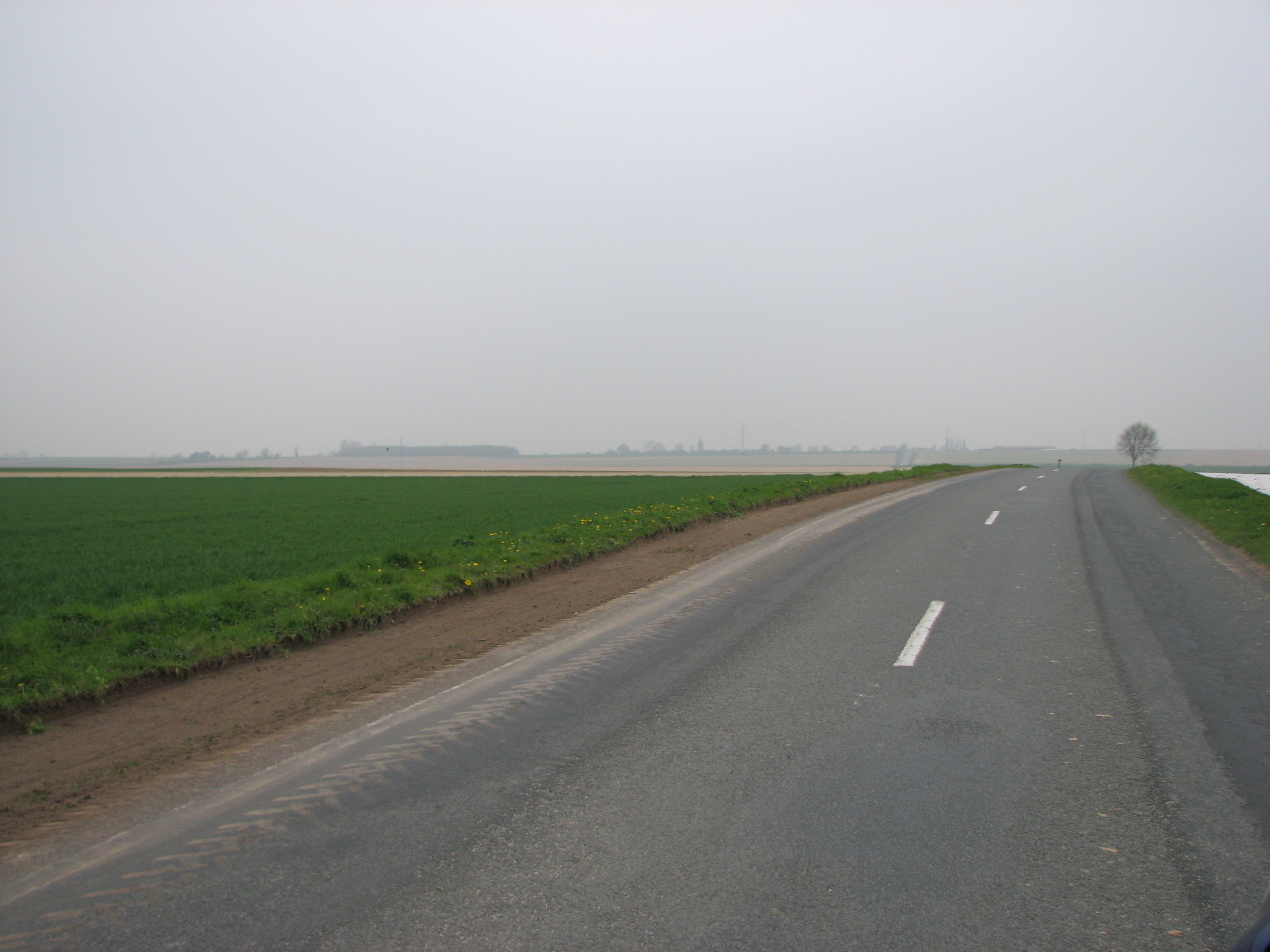Arthur Tatum (1896 - 1919)
Arthur joined up in September 1914 and served for over 2 years on the Western Front with the 11th Battalion of the Essex Regiment. He was wounded and captured during the German Spring Offensive in March 1918. Arthur died of his wounds shortly after his repatriation to the U.K.
- 61
- Died in the Great War
- 51.978244, 1.020661
Details
| Name: | Arthur Tatum |
| Service: | British Army |
| Unit: | 11th Battalion, Essex Regiment |
| Regimental Number: | 12926 |
| Rank: | Private |
| Date of Death: | 9th February 1919 |
| Age: | 22 |
| Commemorated: | East Bergholt Cemetery |
Family Background and Early Life
Arthur Tatum was born on 26th March 1896, in East Bergholt, quite possibly near the Hare and Hounds on Heath Road.
Arthur’s parents Harry Tatum, and his wife Elizabeth (nee Cole) – both from Raydon – had moved to East Bergholt in the early 1890’s, after a short period living near Brantham Mill. Arthur was Harry and Elizabeth’s seventh child. They eventually had 12 children, of whom 10 survived to adulthood.
Arthur started at the School in East Bergholt, which at that time was situated at Burnt Oak Corner, on April Fool’s Day in 1901. He left there exactly eight years, and 7 days later, just after his 13th birthday, which was the school leaving age at that time. After leaving school, Arthur was employed as a Gardener, at least for a time.
Joins the Army
Arthur volunteered to join the Essex Regiment on or around 8th September 1914, at Colchester. It was one month after Britain had declared war on Germany, following the latter’s invasion of neutral Belgium. It is quite possible that Arthur went to join up along with his elder brother George, and another East Bergholt lad, Leonard Peck from Woodgates Cottage, who both enlisted in the Royal Field Artillery on 9th September. 1 George Tatum served with the Royal Field Artillery on the Western Front and later, in Salonica. After he left the Army in 1919, he returned to East Bergholt and lived there until his death in 1980. George is buried in East Bergholt Cemetery.
Another of Arthur’s brothers Harry, also served in the Great War. Harry was a pre-war Regular in the Suffolk Regiment and served with the 1st Suffolks on the Western Front in 1915. He was captured by the Germans during the Second Battle of Ypres in May 1915 and spent the rest of the War as a Prisoner of War. Harry also returned to East Bergholt after the War. He died in 1965 and is buried in the village Cemetery.
The 11th Battalion of the Essex Regiment was constituted at Shoreham in West Sussex in September 1914. It was the third Battalion of the Essex Regiment to be raised specifically for service in the Great War and was made up almost entirely of recruits who had volunteered in the previous weeks.
Another man from East Bergholt who was with the 11th Essex were Abram Dale, from Box Iron. Later in the War, Edward Clarke from Burnt Oak and Herbert Peck, from White Horse Road, were also posted to the Battalion. 2 Abram Dale died of wounds at a Casualty Clearing Station on 26th May 1918, aged 23. Abram is buried in Esquelbecq Military Cemetery, Esquelbecq, France.
Edward Clarke was wounded in the Battle of the Somme, and died of his injuries in hospital in Rouen on 6th October 1916, aged 22. Edward is buried in St. Sever Cemetery, Rouen, France.
Herbet Peck was killed in action on 22nd March 1918, aged 21. After the War, Herbert’s body could not be individually identified, but he is almost certainly buried in Vaulx Hill Cemetery, where he is commemorated by a Special Memorial.
On 21st August, whilst the Battalion were practising trench warfare on Chobham Common, they were notified that they would receive orders to go to France. Just 7 days later an advance party from the Battalion, made up of 3 officers and 103 men (one of whom appears to have been Arthur) left for Southampton, from where they sailed to France.
The Battle of Loos
The remainder of the 11th Essex– consisting 26 officers and 839 other ranks – left for France two days later, this time from Folkestone. They landed in Boulogne that evening.
The Battalion’s first major engagement took place less than a month after arriving in France, during the Battle of Loos. The regimental history states “The Battalion, in its first encounter, suffered the loss of 18 officers and 353 other ranks, but they had the distinction, with the 2nd Welch, of being shown upon a map in the Official History of the War as having reached their objective, even though they could not hold it.” 3 Extract from the page 263 of “The Essex Regiment – 9th, 10th, 11th, 13th and 15th Battalions (Essex Units in the War 1914 – 1919, Volume 6)” by John Wm. Burrows F.S.A., published by John Burrows and Sons, 1935.
In October, the Battalion was moved north, to the Ypres Salient, where they would remain until the end of late July of 1916. Even when not engaged in a major battle, life at the front was extremely hazardous, and casualties were still commonplace even in so- called quiet sectors.
Battle of the Somme
On 3rd August 1916, the 11th Essex left their billets and moved to the Somme, where the great Anglo-French offensive now called the Battle of the Somme had been raging since 1st July. The Battalion manned the trenches in the Ancre Valley for a short period in August, and the following month they were involved in the fighting in between the villages of Ginchy and Lesboeufs.
Their final stint in the front line during the Somme offensive, found the Battalion to the north-east of the village of Guedecourt, before -in October – they were transferred to the Loos Sector, the scene of their baptism of fire in September 1915. They would remain in that sector until 22nd October 1917, when they departed to start intensive training for their part in a coming attack to take place near the French town of Cambrai.
Battle of Cambrai
The Battle of Cambrai, which took place between 20th November 1917 and 7th December 1917, is now perhaps best known for its initial success (gained in part using new techniques in artillery-infantry and tank co-operation), followed by a strong German counter-attack which recaptured much of the ground that had been won.
The 11th Essex successfully achieved their objective on the first day of the Battle and captured the German Support line behind the village of Ribecourt. They were later involved in the defence against the German counter-offensive which started on 30th November. When finally relieved on 11th December, Arthur’s Battalion had spent 28 days of continuous service in the battle line.
Most of the next three months were spent in the area of the Bapaume to Cambrai road. Towards the end of this period – like many units – the Battalion’s efforts were often directed towards fortifying the front line area, and the support positions just behind it.
The British Expeditionary Force, suffering from a manpower crisis and low morale following the heavy fighting and limited success of the previous year, knew that a German attack was expected. In contrast, the German Army on the Western Front had received a massive influx of manpower, having been able to transfer many divisions from the Eastern Front where Russians had signed an Armistice in December.
The German Spring Offensive
The 11th Essex Battalion were in Brigade Reserve when the full force of the German offensive was unleashed on a 46 mile front, in the early hours of 21st March 1918. Elements of the Battalion were involved in the fighting trying to stem the German attacks on that first day.
In the sector allocated to the 11th Essex, and other battalions of the 16th Infantry Brigade, the Germans advanced approximately two miles on that first day. For most of the 22nd, Arthur’s Battalion were fighting to the south of the village of Morchies, and successfully held their positions until the evening when they were ordered to withdraw after the Germans broke through to their north. One of the Battalion’s casualties was Herbert Peck, from East Bergholt, who was killed.
In the day’s fighting, Arthur was wounded in the right calf, and captured by the Germans. He was transported to Germany, and by the end of April was incarcerated in the Munster II Prisoner of War Camp. Munster II, located on the racecourse, was one of four prisoner of war camps in or around that north German city.
Prisoner of War
The conditions in German prisoner of war camps varied greatly, though overcrowding, inadequate housing and poor sanitation appear to have been relatively commonplace. The generally poor quality of the food given to prisoners was often a major cause of illness, which worsened as the war progressed – in large part due to the increasing effectiveness of the British naval blockade against Germany. It should be remembered that at this time, many of the German civilian population themselves were often near starvation.
In many cases it was only the food parcels sent by organisations such as the Red Cross, which prevented many more deaths amongst the British prisoners. In such circumstances – and also given the large influx of new prisoners captured during the German spring 1918 offensives – the health and welfare of the inmates were unlikely to have been a high priority for the German authorities.
To add to the questionable conditions, as a Private Arthur may also have been put to work by his captors – either in agriculture or industry – as it was only officers who were not permitted to work under the 1907 Hague Convention.
Repatriation
Arthur appears to have been repatriated to the UK shortly after the Armistice, possibly in the December of 1918. He was in very poor health and may not even have been able to travel back to East Bergholt.
Arthur received treatment at Lewisham Hospital, and by early February had been transferred to the East Suffolk Hospital in Ipswich. There, on 9th February 1919 – Arthur passed away. His Death Certificate states the causes of death were General Service Wound in the right leg, and septicaemia.
It is a sad fact, that having survived the conflict itself, many serviceman succumbed to their injuries in the months or years following the war. Arthur himself may possibly have survived had he have received better care during his time as a prisoner of war. Certainly his family believed that to be the case, and that his death was caused “through his wounds being neglected during his nine months’ imprisonment at the Munster Camp”. 4 From a Notice placed by the Tatum family in the In Memorium section of the “Suffolk Chronicle and Mercury”, 21st March 1919.
Arthur was laid to rest in East Bergholt Cemetery. His grave is marked by a headstone erected by his family, though it has sadly received some damage over the years so that only the base with its inscription now remains.
Copyright © Mark Ashmore, 2024
- 61
- Died in the Great War
- 51.978244, 1.020661



